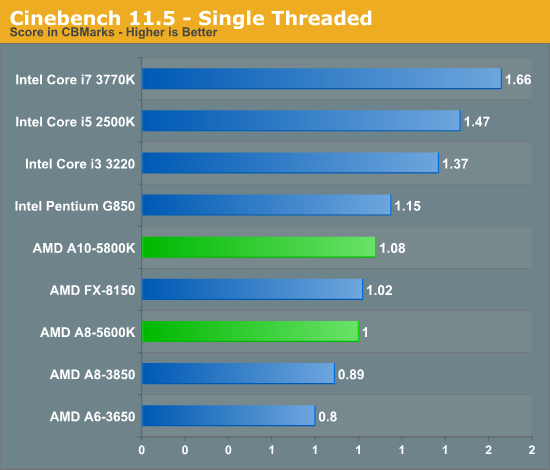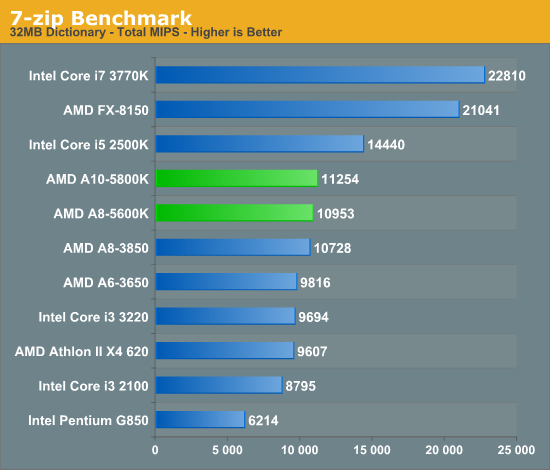AMD A10-5800K & A8-5600K Review: Trinity on the Desktop, Part 2
by Anand Lal Shimpi on October 2, 2012 1:45 AM ESTTrinity CPU Performance: The Good and the Bad
We're going to start our performance investigation a little out of order. The big question on everyone's mind is how much single threaded performance has improved over Bulldozer, and whether it's enough to actually make Trinity faster than Llano across the board. We'll use Cinebench 11.5 as it has both single and multithreaded test options:

The good news is that single threaded performance is definitely up compared to Llano. Piledriver likely has some to do with this, but so does the fact that the A10 can run at up to 4.2GHz (~4GHz typically) with one of its cores active compared to the 2.9GHz clock speed of the A8-3850. Compared to the Bulldozer based FX-8150 there's a slight (~6%) increase in single threaded performance. Although I don't expect anyone will be cross shopping a Trinity APU and a FX CPU, it's important to keep an eye on progress here as we'll eventually get a high-end quad-module/eight-core Piledriver CPU.
Note that compared to even previous generation, low-end Intel CPUs without turbo there's a huge gap in single threaded performance. If we look at the gap AMD has to make up vs. Ivy Bridge it's not pretty. Intel's Core i3 3220 manages a 27% performance advantage over the A10-5800K. Even if Steamroller is able to deliver a 15% increase in performance at the same clock speed, there will still be a gap. And we're not even talking about how Haswell will grow this gap. For the foreseeable future I don't see AMD closing the single threaded performance gap. Jim Keller's job is to fix this problem, but it'll probably take 2 - 3 years to get there.

The multithreaded test shows the other end of reality: in heavily threaded foating point workloads it's possible that we'll see a regression compared to Llano. Remember the Bulldozer/Piledriver architecture prioritizes integer over floating point performance. Truth be told this regression is pretty rare in our tests, but until we get to Steamroller we will still see these types of situations.
Throw more threads at the problem and even with a floating point workload Intel can't pull ahead however. The A10 offers similar performance to the Core i3 3220 at a lower price. Your decision here would come down to the rest of the factors: single threaded performance, processor graphics performance, overclocking capabilities and power consumption. Intel and AMD both win two of those each, it's really a matter of what matters most to you.
A heavily threaded FP workload doesn't really play to AMD's advantages though, what happens when you get a heavily threaded integer workload however? The 7-zip benchmark gives us just that:

Here AMD manages a 16% performance advantage over the Core i3 3220. I'd even go as far as to say that Trinity would likely beat any dual-core Intel machine here. The performance advantage is somewhat artificial as Intel purposefully removes turbo from its dual-core desktop CPUs. This should be AMD's best foot forward, but once again it'll likely take Steamroller for this design to start to make sense.
Speaking of artificial product segmentation, one major feature Intel takes away when you get down to the dual-core desktop i3 level is AES-NI support. Hardware accelerated AES support is something that you get only with the more expensive Core i5/i7s. With Trinity, you get AES-NI support for the entire stack. The result is much better performance in those applications that depend on it:

Like most of the advantages we've talked about thus far, there are really very specific use cases where Trinity makes sense over a similarly priced Intel CPU.










178 Comments
View All Comments
silverblue - Tuesday, October 2, 2012 - link
They are going to.http://www.anandtech.com/show/6201/amd-details-its...
Origin64 - Wednesday, October 3, 2012 - link
That's what they said about Trinity last year. I'm not buying it, not since Bulldozer.CeriseCogburn - Tuesday, October 9, 2012 - link
Yep, it's always the future, the next one, for the amd fanboysean.crees - Wednesday, October 10, 2012 - link
I agree, the best case scenario for AMD is the A10-5700 with 65 watt TDP in a SFF ITX enclosure utilizing the integrated GPU.ac2 - Tuesday, October 2, 2012 - link
Oops that last line should read "That puts a $50 saving towards..." not $70So:
- Pentium G850: $70 (HD2000 less Quicksync)
- Gigabyte GA-B75M-D3V: $70 (with PCIe 3.0 and USB 3.0 onboard)
Can easily upgrade to a more powerful GPU/ CPU down the line..
cyrusfox - Tuesday, October 2, 2012 - link
Correction to your commentThe G850 will only support PCIe 2.0, you would need to wait for Ivy refresh of celeron/pentium.
If it was me and I was going cheap/Intel, I would just buy a Celeron G530 for $40, why bother with the G850, its just as handicapped with a little more CPU freq.
But trinity would be a whole lot more fun to play with then those chips even though it may be slower doing a lot of the same task. Some of us just enjoy overclocking while undervolting while rooting for the perpetual underdog.
CaptainDoug - Tuesday, October 2, 2012 - link
The G850 has Intel HD 2000 graphics. Big step up. Also as far as motherboard compatibility, if you go with a celeron, your choices for boards that are also compatible with i3, i5, i7 boards is slim pickin's. Going with a pentium gives you more advanced motherboard options. I agree that the G530 is a great CPU for cheap but it's just a little harder to upgrade to anything amazing. Trinity is quite interesting though. Would be great in a small desktop for the wife.wwwcd - Wednesday, October 3, 2012 - link
HD 2000 is a scrap ;)rarson - Wednesday, October 3, 2012 - link
Having Intel graphics is not, in any way, a plus. Especially a turd like HD2000.delirious7 - Tuesday, October 2, 2012 - link
how is the ivy bridge pentiums or celerons going to have pci express 3.0 when even the core i-3 processors don't? intel decided to omit pci express 3.0 from everything under an core i5.the only thing besides a slightly better clock for clock that ivy gives you with the ivy bridge pentiums is memory support up to speeds of 1600 instead of 1333 like sandy bridge.